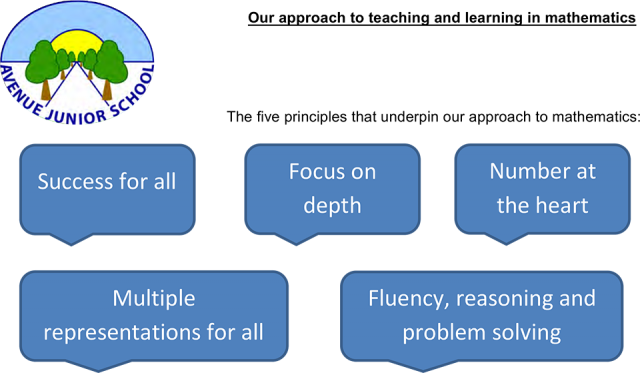
Success for all
All pupils can achieve in mathematics.
A positive teacher mind set and strong subject knowledge are key to student success in mathematics. It is not the case that some pupils can do mathematics and others cannot.
No pupil should be left behind. The focus is on keeping up over catching up. By making high expectations clear and emphasising the value of mathematics education, pupils are encouraged to build confidence and resilience.
Abilities are neither fixed nor innate, but can be developed through practice, support, dedication and hard work. Natural talent is just a starting point and does not determine who has more or less potential to achieve. A positive teacher mind set in maths encourages a love of learning and resilience that enables everyone to achieve.
Focus on depth
Deepen understanding before accelerating content coverage.
All pupils benefit from deepening their conceptual understanding of mathematics, regardless of whether they’ve previously struggled or excelled. Pupils must be given the time to fully understand, explore and apply ideas, rather than accelerate through new topics. This approach enables pupils to truly grasp a concept, and challenge comes from investigating it in new, alternative and more complex ways.
Number at the heart
Secure the fundamentals
A large proportion of time is spent reinforcing number to build competency and fluency. Number is at the heart of our teaching, with more time being devoted to this than other areas of mathematics. It is important that pupils secure these key foundations before being introduced to more difficult concepts. This increased focus on number allows pupils to explore the concepts in more detail and secure a deeper understanding. Key number skills are fed through all maths lessons so that pupils become increasingly fluent.
Multiple representations for all
Concrete, pictorial, abstract
Objects, pictures, words, numbers and symbols are everywhere. Our approach incorporates all of these to help pupils explore and demonstrate mathematical ideas, enrich their learning experience and deepen understanding. Together, these elements help cement knowledge so pupils truly understand what they have learnt.
All pupils, when introduced to a new concept, should have the opportunity to build competency in this topic by taking this approach. Pupils are encouraged to physically represent mathematical concepts. Objects and pictures are used to demonstrate and visualise abstract ideas, alongside numbers and symbols.
Concrete – Pupils should have the opportunity to use concrete objects and manipulatives to help them understand and explain what they are doing.
Pictorial – Pupils should build on this concrete approach by using pictorial representations. These representations can then be used to reason and problem solve.
Abstract – With the foundations firmly laid, pupils should be able to move to an abstract approach using numbers and key concepts with confidence.
Fluency, reasoning and problem solving
Teaching supports the aims of the National Curriculum.
Problem solving – mathematical problem solving is at the heart of our approach. Pupils are encouraged to identify, understand and apply relevant mathematical principles and make connections between different ideas. This builds the skills needed to tackle new problems, rather than simply repeating routines without a secure understanding.
Mathematical concepts are explored through a variety of representations and problem solving contexts to give pupils a richer and deeper learning experience. Pupils combine different concepts to solve complex problems, and apply knowledge to real-life situations.
Reasoning – the way pupils speak and write about mathematics transforms their learning. Our approach puts introducing and reinforcing mathematical vocabulary at the heart of all lessons. Pupils explain the mathematics in full sentences. They should be able to say not just what the answer is, but how they know it’s right. This is key to building mathematical language and reasoning skills.
Fluency – Pupils should be able to recall and apply mathematical knowledge both rapidly and accurately. However, it is important to stress that fluency is not memorisation – it is far more than this. As well as a fluency of facts and procedures, pupils should be able to move confidently between contexts and representations, recognise relationships and make connections in mathematics. This will help pupils develop a deep conceptual understanding of the subject. Frequent, carefully designed, intelligent practice will help them achieve a high level of fluency.
